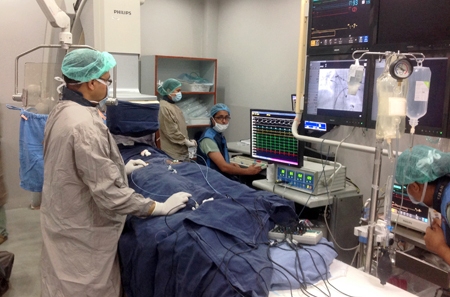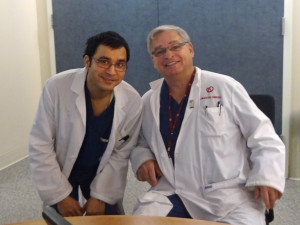In March of this year, following a two-year fellowship in Canada, Roshan Raut, MD, returned to his native Nepal as only the third doctor trained in cardiac electrophysiology in his country’s history and the first trained in complex ablation techniques. He was eager to get to work expanding the availability of Nepalese arrhythmia care. Then on April 25, while checking out of a Kathmandu hotel with his wife and two young children, a 7.8-magnitude earthquake hit. The quake and resulting damage would make international news for weeks.

“It was one of the most dreadful experiences I ever had in my life,” he said. “My children aren’t even old enough to know the word for earthquake.” He was at a loss to explain to them what was happening, as they sheltered under the nearest door frame in the hotel lobby. Once the ground stopped shaking, Dr. Raut stepped outside to find that a quarter of the hotel had collapsed, including the staircase to the room they had vacated minutes earlier.
The next few months would turn out very differently than he had imagined. His hospital would have to balance treating the victims of the earthquake with carrying out plans to build the country’s first comprehensive electrophysiology (EP) centre. Yet, despite the challenges, he has already treated an arrhythmia with a complex cardiac ablation procedure never before performed in Nepal.
One Centre, 30 Million People
As the most extensively trained electrophysiologist in the country, Dr. Raut has brought back a wealth of knowledge from his fellowship at the University of Ottawa Heart Institute. He had heard about the program from an anesthesiology colleague who had also trained at the Heart Institute.
“We don’t actively advertise our fellowship program, but we have an international reputation,” said David Birnie, MD, Director of the Arrhythmia Service at the Heart Institute. “A lot of our fellows hear about it through word of mouth.” That was Dr. Raut’s path to Ottawa, but it had been a long road to that point.
As a top student in secondary school, he decided to pursue medicine in order to help fill the health care gap in his country. But he ran into complications when his medical school in Nepal closed. Eventually, he won a place—and a full scholarship—at a university in China.
The catch was that he had to take a full year of Chinese language lessons before he could even start his medical studies. “At first, reading one page took two hours,” Dr. Raut recalled. He picked the language up quickly, though, and went on to obtain his medical degree in China. In 2004, he returned to Nepal as a cardiologist at the Sahid Gangalal National Heart Centre in Kathmandu.
His exposure to electrophysiology had been limited, but the National Heart Centre was actively trying to build an EP program—the first in Nepal. Training offered by visiting physicians from the United States and India made it possible for Heart Centre cardiologists to start treating arrhythmias with basic ablation procedures.
Still, it was the only centre performing any type of EP procedure for a population nearly as large as Canada’s, and complex procedures, such as those to treat ventricular tachycardia or atrial fibrillation/flutter, were beyond the centre’s technical expertise.
“Since we were the only centre in Nepal, we thought that it was our job to upgrade the country’s electrophysiology service,” said Dr. Raut.
Bringing Expertise Back Home
The timing for his fellowship was fortuitous. Not only did he get two years of intensive training at the Heart Institute, including complex ablations and pacemaker and ICD/CRT (implantable cardioverter defibrillator/cardiac resynchronization therapy) implantation. He also became the first cardiologist in the world to receive a new certification in electrophysiology from the Royal College of Physicians and Surgeons of Canada. (See the sidebar “Leading the Development of National Standards.”)

Since his return to Nepal, Dr. Raut has been building a team to support complex ablations, and in June, he performed Nepal’s first-ever ventricular tachycardia ablation. Remarkably, the team managed the task without the standard 3-D mapping software commonly used elsewhere. They plan to have such a system in place next year.
“I’m hopeful that we will be doing all sorts of complex ablations,” said Dr. Raut. “And once we have a formal electrophysiology service, we’ll be teaching other doctors so that we won’t be the only centre for 30 million people.”
Under Martin Green, MD, Director of the Postgraduate Electrophysiology Fellowship Program, the Heart Institute currently has teaching relationships through former students in countries including India and South Africa. Dr. Raut hopes that a similar training opportunity could be established with Nepal.
“We have three pillars at the Heart Institute: patient care, education and research,” said Dr. Birnie. “It’s a priority for our group to train people from overseas. We really believe that it’s part of our academic mission.”
The relationships between trainers and trainees often continue long after international fellows return to their home countries. “We love for them to email us about patients, and many continue to correspond with us for five, 10 or more years,” said Dr. Birnie. “It’s a lifelong relationship.”
Despite the damage wrought by the Nepal earthquake, Dr. Raut feels optimistic about the future, of both the growing EP program and his country in general: “Since the earthquake, I think people have been more likely to cooperate with each other, more helpful and more united,” he said. “These shifts in thinking will be helpful for our future.”

Dr. Martin Green has led the Heart Institute’s EP training program for more than 20 years. During that time, he has seen his field advance greatly in terms of complexity and scope. Along the way, he became convinced of the need for national training standards to ensure a consistent degree of excellence in both teaching and practice.
“What does it really take to train a cardiac electrophysiologist and to be sure that there is, if not uniformity, at least excellence in every institution across the country?” he and several colleagues found themselves asking. As they began drafting a document to address these issues, the Royal College of Physicians and Surgeons of Canada happened to select EP as only the second area of postgraduate medical education for designation as an Area of Focused Competence (AFC).
“This is a new category under which [the Royal College] recognizes appropriate training and creates standards for training in that area,” explained Dr. Green.
He became chair of a national committee tasked with creating the standards by which university EP training programs could become accredited by the Royal College. These standards were finalized in 2012, and to date, two institutions have completed the exacting process: the University of Ottawa Heart Institute and Western University in London, Ontario. Fellows completing their training at either institution can now submit a portfolio of cases to the Royal College for assessment. If successful, the trainees receive a diploma in the AFC of electrophysiology.
“This is the beginning of the journey of ‘competence by design,’” explained Dr. Green, by which expertise is assured across the country through thoughtful design of the training process. “And we’re in the vanguard.”
Heart Institute trainee Dr. Raut was the first physician accredited through the electrophysiology AFC program.

